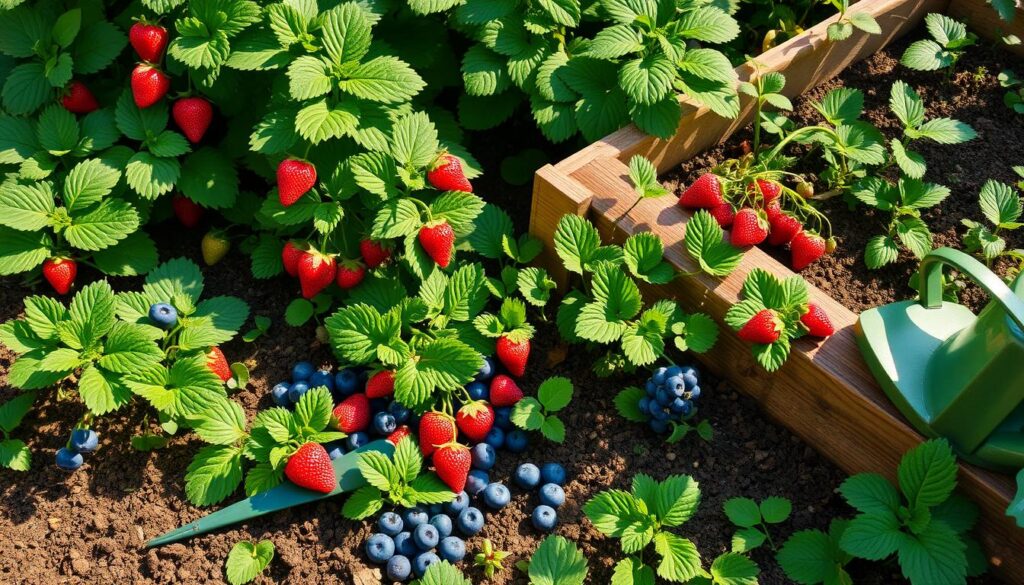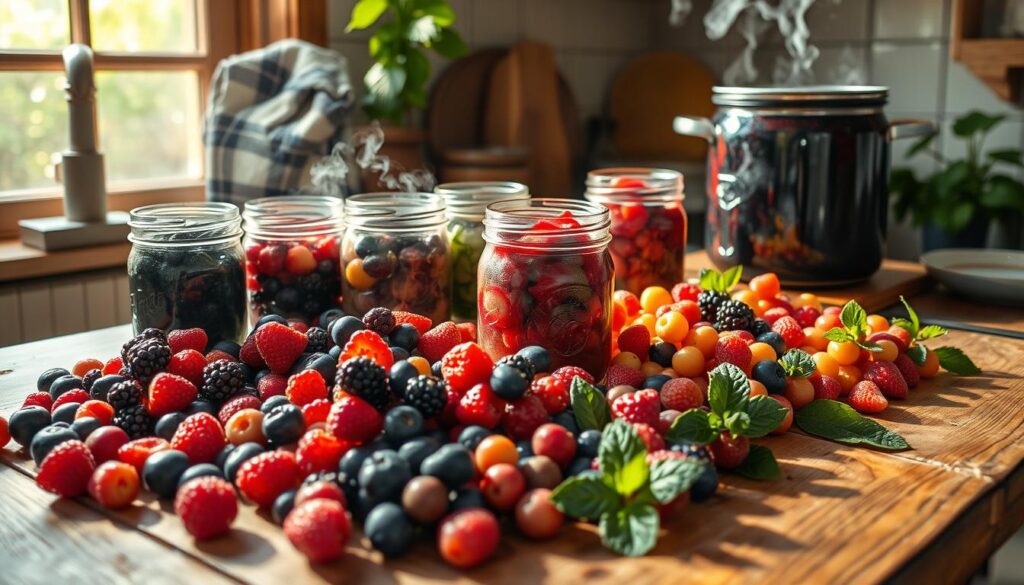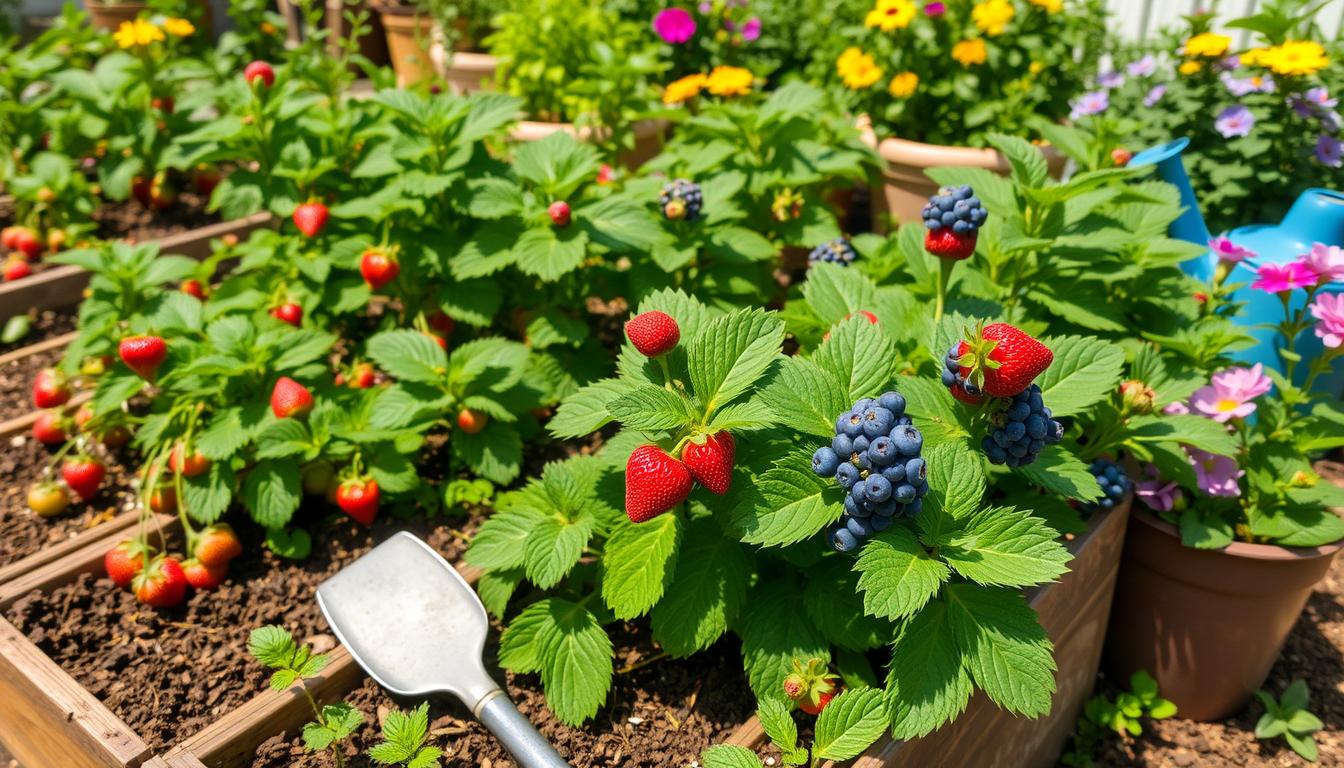Growing organic berries at home is rewarding and delicious. I’ll share tips and knowledge from my own gardening. You can see results quickly, often in the same year.
Choosing the right berries, understanding soil, and caring for your garden are key. These steps are essential for a successful garden.
I’ve picked blueberries and raspberries for years. I’ve learned a lot, like picking the best varieties and caring for them. For blueberries, soil pH and watering are crucial, especially in the first year.
Let’s explore how to grow your own organic berry garden. It’s a journey worth taking.
Key Takeaways
- Choose suitable berry varieties to maximize your harvest.
- Ensure the right soil conditions, particularly pH levels for blueberries.
- Water deeply at planting and monitor irrigation in the first year.
- Invest in companion planting for better growth outcomes.
- Maintain your garden with organic materials like mulch and compost.
Why You Should Grow Organic Berries at Home
Growing organic berries at home adds color and flavor to my garden. They are packed with nutrients like antioxidants, vitamins C and K, and dietary fiber. These nutrients are key for a healthy diet and can help prevent diseases.
Organic gardening is rewarding and good for the planet. It cuts down on carbon emissions from transportation and packaging. My garden also supports local wildlife and beneficial insects.
Having berries at home boosts food security. I can enjoy them fresh and avoid store-bought options. Plus, they grow quickly, so I can harvest them in the same year.
Organic berry gardening is a hobby that brings joy. From planting to harvesting, it’s a fulfilling journey. Picking fresh berries adds a special touch to my cooking and sharing with loved ones.
The Best Types of Berries for Home Gardening
Home gardening offers a wide range of berries to grow. Raspberries, blueberries, strawberries, and blackberries are top picks. They are easy to grow and add amazing flavors and colors to your garden.
Raspberries love sunlight and well-draining soil. They produce sweet fruits that you can pick many times a season. This makes them a hit with gardeners.
Blueberries need acidic soil, with a pH of 4.5 to 5.5. They can give you 4 to 6 quarts of berries a year. Make sure they get at least six hours of sunlight and enough space for air.
Strawberries, especially day-neutral types, give you berries from late spring to fall. They do well in well-draining, slightly acidic soil and need regular water. Plus, they spread out, making a strong patch over time.
Blackberries need lots of space, with trailing types needing 10 feet between each plant. They grow well in full sun and can produce fruit for up to ten years. This makes them a great choice.
Trying out berries like huckleberries or goji berries can make your garden more interesting. Growing a mix of berries not only adds variety but also helps with biodiversity and keeps your harvest going. With the right planning, you can enjoy a rich harvest from your garden.
How to Grow Organic Berries at Home
Growing organic berries at home is rewarding. Start by picking the best berry plant location for growth. Berries love sunny spots with at least six hours of sunlight. Make sure your garden beds or containers have good air flow and drainage to avoid root rot.
Selecting the Right Location for Berry Plants
Choosing the right berry plant location is key. Look for spots with full sun to help the plants grow well. Also, pick areas that protect from strong winds. Berries like blueberries need well-drained, slightly acidic soil, while strawberries have different needs.
Understanding Soil Requirements
The soil requirements for berry plants are important. Use high-quality, organic soil with compost and worm castings for healthy plants. Blueberries need a pH between 4.5 and 5.5. Test your soil often to keep it right. Mulching with organic matter helps keep the soil moist and controls weeds.
Choosing the Right Berry Varieties
Knowing which berry varieties to grow is crucial. Strawberries produce fruit the first summer after planting. Fall-bearing raspberries give fruit from late summer to early frost. Thornless blackberries are disease-resistant and sweet. Currants come in red, black, and white and are great for fresh eating or preserves. Choose varieties that fit your growing conditions for better taste and yield.
Essential Tips for Berry Cultivation
To grow berries well, you need good techniques and a focus on green gardening. It’s key to water them right for their health and growth. Keeping the soil moist, especially when it’s dry, helps berries grow strong and give lots of fruit.
Best Practices for Watering Berries
Learning how to water berries right is a big part of growing them. Here are some tips I’ve picked up:
- Water deeply and often, especially when it’s hot.
- Use drip irrigation or soaker hoses to save water and help plants absorb it better.
- Check the soil’s moisture; it should be damp but not wet.
- Put mulch around plants to keep moisture in and control soil temperature.
Sustainable Gardening Techniques for Healthy Growth
Using sustainable gardening methods makes your berry plants healthier and helps the planet. Here are some ways to make your garden better:
- Use organic compost to make the soil rich with nutrients.
- Plant cover crops like winter rye to make the soil better.
- Try companion planting to add variety and help control pests.
- Check for pests and diseases often and use natural solutions when you find them.

These steps help your berries grow well and make your garden better for the environment. For more tips, check out Gardenbeginner for advice and community support.
| Berry Variety | Watering Needs | Soil Type | Best Practices |
|---|---|---|---|
| Blueberries | Consistent moisture | Acidic, well-drained | Use peat moss for acidity |
| Strawberries | Moderate, well-drained | Loamy or sandy | Mulching to suppress weeds |
| Raspberries | Regular deep watering | Well-drained | Prune annually for air circulation |
Common Problems in Growing Berries
Growing berries can be challenging, especially with pests and diseases. Birds and insects can harm your berry crop. Taking good care of your berries can help solve these problems.
Pests and How to Manage Them
Managing pests is key to a successful berry garden. I use several methods to keep pests away:
- Physical barriers like nets or row covers keep birds and pests out.
- Organic treatments, like neem oil or insecticidal soaps, fight insects safely.
- Checking plants often helps catch pest problems early.
Disease Prevention Tips
Managing diseases is also important for healthy berries. Here are some tips I find helpful:
- Choosing disease-resistant varieties lowers the risk of diseases like Phytophthora root rot.
- Good spacing between plants helps with airflow and reduces humidity.
- Drip irrigation prevents waterlogged soil that diseases love.
For more berry care tips, check out more resources on pest and disease management. Being informed and proactive leads to a thriving berry garden.
| Pest Type | Management Strategy |
|---|---|
| Birds | Use nets or reflective tape |
| Aphids | Apply insecticidal soap |
| Slugs | Handpick or use beer traps |
| Spider mites | Introduce beneficial insects like ladybugs |
Berry Plant Maintenance and Care
Keeping berry plants healthy is key to a good harvest. Regular care includes watching their growth and doing important tasks like pruning and mulching. These steps help plants grow better and produce more fruit. Knowing how to prune and the perks of mulching can really help your berry plants thrive.
The Importance of Pruning
Pruning is crucial for berry plants’ health and fruit. Blueberry bushes don’t need pruning in their first year. But when they grow up, it’s important to prune them right. Prune by cutting off old canes and inward-pointing branches in late winter or early spring. This lets air in and helps more fruit grow.
It’s good to prune every year and sometimes more to keep plants growing new. This keeps them healthy and productive.
Mulching for Optimal Growth
Mulching around berry plants has many mulching benefits. It keeps the soil moist, stops weeds, and protects the roots. For blueberry bushes, a thick layer of mulch in winter keeps them warm. Mulching makes the plants grow better and stronger.
| Technique | Description | Benefits |
|---|---|---|
| Pruning | Remove old canes and shape plants in late winter or early spring. | Encourages new growth and improves airflow. |
| Mulching | Apply organic mulch around plants. | Conserves moisture, prevents weeds, and insulates roots. |
| Watering | Use 1″-2″ of water weekly, increasing during fruit ripening. | Maintains consistent moisture levels for healthy plant growth. |
Harvesting Your Homegrown Organic Fruit
Knowing when and how to pick berries is key to enjoying them at their best. Each berry type shows ripeness in its own way. This makes harvesting a fun challenge during the growing season. By watching for these signs, I can know exactly when to harvest.
When to Harvest Different Types of Berries
Here are some guidelines for various berries:
- Raspberries: These berries come off easily when ripe. Look for a deep color and a bit of softness.
- Blackberries: They’re ready when dark and soft. Unlike raspberries, blackberries keep their core when picked.
- Strawberries: Pick them when they’re bright red and a bit firm. This means they’re sweet and juicy.
- Blueberries: They should be fully blue and look plump. This means they’re ready to be picked.
How to Properly Store Your Berries
After picking my berries, it’s important to store them right to keep them fresh. Here’s how to do it:
- Gently put berries in a container that lets air through to avoid damage.
- Don’t wash berries until you’re ready to eat them. Water can make them spoil faster.
- Keep berries in the fridge, but eat them soon. They start to go bad in a day or two.
By following these steps, I can enjoy the taste of my homegrown berries for longer. Harvesting and storing berries shows the joy of growing my own food. It makes my garden a place of abundance and delight.
Preserving Your Berry Harvest
Preserving berries lets me enjoy their flavors even when they’re not in season. I try out simple jam recipes and freezing techniques to keep them fresh. Learning these methods helps me manage my garden’s bounty.
Making Jams and Jellies
Making jams and jellies is both easy and rewarding. I use fruits from my garden, choosing homemade recipes without refined sugar or pectin. This way, I keep the berries’ natural sweetness and control what goes into my pantry.
Here’s how to make tasty berry jam:
- Pick ripe berries for the best flavor.
- Wash the berries well in a mix of 3 cups water and 2 tablespoons vinegar for 5 to 10 minutes.
- Crush the berries with a fork or potato masher.
- In a saucepan, mix the crushed berries with honey or maple syrup to taste.
- Bring the mix to a boil, then simmer until it thickens.
- Pour into sterilized jars and seal them.
This method keeps the berries fresh and makes a great spread for breakfast, snacks, and desserts.
Freezing Techniques for Long-Term Storage
Freezing berries is a great way to keep their flavor and nutrients. It’s better than canning, as it keeps berries fresher for longer. Here’s how I freeze berries:
- Rinse the berries with the water and vinegar solution.
- Let them dry on a clean towel.
- Put the berries on a baking sheet and freeze until solid.
- Put the frozen berries in airtight containers or bags, removing air to prevent freezer burn.
- Label and date the containers for easy identification.
By following these steps, I can keep berries fresh for up to a year. This way, I can enjoy summer’s taste long after it’s gone.

| Berry Type | Spoilage Rate | Freezing Method |
|---|---|---|
| Raspberries | 3-5 days | Freeze unwashed, then rinse before use |
| Strawberries | 5-7 days | Slice before freezing to save space |
| Blueberries | 7-10 days | Freeze in single layer |
| Blackberries | 4-6 days | Flash freeze for easy storage |
Knowing how to preserve berries lets me enjoy my garden’s flavors all year. It boosts my cooking and keeps my diet healthy.
Maximizing Your Berry Yield
To get the most berries, you need to know what your plants need. Using companion planting helps them grow better and keeps pests away. Also, making your garden the best place for berries makes them healthier and more productive. Let’s look at some key strategies for these areas.
Companion Planting with Berries
Companion planting is when you grow different plants together for their benefits. It helps berry plants grow strong and keeps pests off. For example, growing chives or marigolds with currants and gooseberries keeps insects away and adds nutrients.
It’s also important to plant different blueberry bushes close to each other. This helps them pollinate and increases fruit. Seeing how these plants work together in my garden is amazing. It makes the soil better and makes the garden look great.
Creating Optimal Growing Conditions
For berry plants to do well, they need the right conditions. Blueberries, for instance, love acidic soil with a pH of 4.0-5.5. Adding compost to the soil helps it hold moisture and nutrients better.
Pruning gooseberries and currants in early March helps them grow. It removes dead or sick branches. Making sure they get enough sunlight is also key. Grapes need full sun to grow well.
Knowing how long it takes for plants to grow is important. Blueberries take 2-3 years to start and 8-10 years to be fully grown. Understanding this helps me plan better for my berry garden.
| Berry Type | Optimal Soil pH | Establishment Time (Years) | Full Maturity Time (Years) |
|---|---|---|---|
| Blueberries | 4.0 – 5.5 | 2 – 3 | 8 – 10 |
| Currants | 6.0 – 7.0 | 1 – 2 | 3 – 4 |
| Gooseberries | 6.0 – 7.0 | 1 – 2 | 3 – 4 |
| Grapes | 5.5 – 7.0 | 1 – 2 | 3 – 5 |
Using these methods makes growing berries rewarding and successful. For more tips, check out my privacy policy on my blog.
Lessons Learned from Experienced Berry Growers
In my journey to grow organic berries, I’ve learned a lot from experienced growers. Talking to local organic farms has given me practical tips and insights. These lessons have not only improved my gardening skills but also encouraged others to grow berries with confidence.
Advice from Local Organic Farms
At Sunny Creek Organic, I learned about protecting berries from sunburn. Using shade cloth covers is key. It helps keep the berries healthy and promotes plant growth.
Managing disease, like Phytophthora root rot, is also important. Knowing which raspberry varieties resist disease helps prevent these problems.
Community Resources for Berry Growers
Community gardening resources are incredibly valuable. Online forums and local clubs are full of helpful tips. They offer advice on pests and preserving crops.
I suggest checking out local farms’ advice. It’s often more practical than what you find in books. For more on growing organic berries, see this resource.
The Benefits of Growing Berries Naturally
Growing berries naturally has many benefits for both our health and the environment. It helps us live a sustainable lifestyle while enjoying tasty fruits.
Health Benefits of Organic Berries
Organic berries like raspberries and blackberries are packed with nutrients. They are full of anthocyanins, quercetin, Vitamin C, and fiber. These nutrients are great for our health.
Eating these berries can boost our overall health. Plus, they taste better because they’re free from harmful chemicals.
Environmental Impacts of Sustainable Berry Growing
Sustainable gardening is good for the planet too. Plants like berries need less water and fertilizer than other crops. They also grow well in less sunlight.
By growing berries, we help the environment. We use less water and fewer chemicals. This also attracts beneficial wildlife to our gardens.
Buying from local nurseries, like Stark Bros. Nursery, supports sustainable gardening. It helps us grow our own berries, reducing our carbon footprint.
Conclusion
Starting to grow organic berries at home is a rewarding journey. It brings you delicious fruits and a healthier lifestyle. I’ve shared tips and insights to help you grow and enjoy your berries easily.
Whether it’s blueberries in containers or goji berries in the right spot, the joy of harvest is unique. Growing organic berries means enjoying their taste and helping the environment.
Understanding each berry’s needs, like soil and sunlight, is key. I encourage everyone to use their space, whether it’s a balcony or backyard. With the right steps, growing organic berries can improve your gardening skills.
Growing berries connects us to nature and supports sustainable living. I hope these tips inspire you to start your berry-growing journey. It will bring many joys to your gardening experience.



Leave a Reply